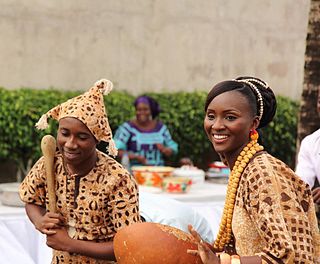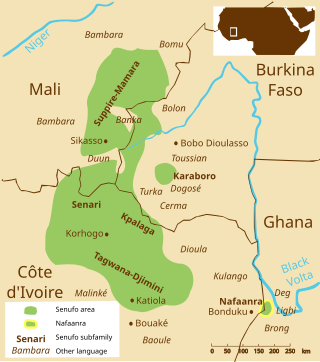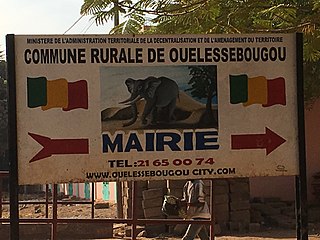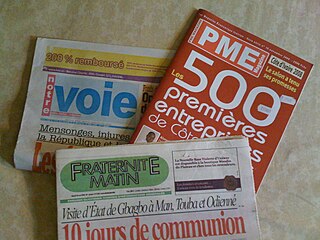
Niger–Congo is a hypothetical language family spoken over the majority of sub-Saharan Africa. It unites the Mande languages, the Atlantic-Congo languages, and possibly several smaller groups of languages that are difficult to classify. If valid, Niger-Congo would be the world's largest in terms of member languages, the third-largest in terms of speakers, and Africa's largest in terms of geographical area. It is generally considered to be the world's largest language family in terms of the number of distinct languages, just ahead of Austronesian, although this is complicated by the ambiguity about what constitutes a distinct language; the number of named Niger–Congo languages listed by Ethnologue is 1,540.

The Senufo or Senufic languages has around 15 languages spoken by the Senufo in the north of Ivory Coast, the south of Mali and the southwest of Burkina Faso. An isolated language, Nafaanra, is also spoken in the west of Ghana. The Senufo languages constitute their own branch of the Atlantic–Congo sub-family of the Niger–Congo languages. Garber (1987) estimates the total number of Senufos at some 1.5 million; the Ethnologue, based on various population estimates, counts 2.7 million. The Senufo languages are bounded to the west by Mande languages, to the south by Kwa languages, and to the north and east by Central Gur languages.

The Gur languages, also known as Central Gur or Mabia, belong to the Niger–Congo languages. They are spoken in the Sahelian and savanna regions of West Africa, namely: in most areas of Burkina Faso, and in south-central Mali, northeastern Ivory Coast, the northern halves of Ghana and Togo, northwestern Benin, and southwestern Niger. A few Gur languages are spoken in Nigeria. Additionally, a single Gur language, Baatonum, is spoken in Benin and in the extreme northwest of Nigeria. Three other single Gur languages, the Tusya, Vyemo and Tiefo languages, are spoken in Burkina Faso. Another unclassified Gur language, Miyobe, is spoken in Benin and Togo. In addition, Kulango, Loma and Lorhon, are spoken in Ghana, Ivory Coast and Burkina Faso. Additionally, a few Mossi speakers are in Senegal, and speakers of the Dagaare language are also found in Cameroon. The Samu languages of Burkina Faso are Gur languages.

The Senufo people, also known as Siena, Senefo, Sene, Senoufo, and Syénambélé, are a West African ethnolinguistic group. They consist of diverse subgroups living in a region spanning the northern Ivory Coast, the southeastern Mali and the western Burkina Faso. One sub-group, the Nafana, is found in north-western Ghana.
Ferkessédougou is a city in northern Ivory Coast. It is a sub-prefecture of and the seat of Ferkessédougou Department. It is also the seat of Tchologo Region in Savanes District and a commune. Ferkessédougou is the second-most populous city in northern Ivory Coast, after Korhogo.

Nafaanra, also known as Nafanan or Nafana, is a Senufo language spoken in northwest Ghana, along the border with Ivory Coast, east of Bondoukou. It is spoken by approximately 90,000 people. Its speakers call themselves Nafana, but others call them Banda or Mfantera. Like other Senufo languages, Nafaanra is a tonal language. It is somewhat of an outlier in the Senufo language group, with the geographically-closest relatives, the Southern Senufo Tagwana–Djimini languages, approximately 200 kilometres (120 mi) to the west, on the other side of Comoé National Park.

Supyire, or Suppire, is a Senufo language spoken in the Sikasso Region of southeastern Mali and in adjoining regions of Ivory Coast. In their native language, the noun sùpyìré means both "the people" and "the language spoken by the people".
The Sucite language or Sicite is a Senufo language spoken in southwestern Burkina Faso and Mali by approximately 35,000 people. Sucite is a close neighbour of the Supyire language, spoken in southeastern Mali. Sucite is sometimes regarded as the northern extension of the Supyire language. The two dialects are, according to Garber (1987), ‘quite mutually intelligible’. Sometimes speakers of Sucite will even refer to themselves as speaking Supyire. Another closely related lect is Mamara.

Minyanka is a northern Senufo language spoken by about 750,000 people in southeastern Mali. It is closely related to Supyire. Minyanka is one of the national languages of Mali.

Mali is a multilingual country of about 21.9 million people. The languages spoken there reflect ancient settlement patterns, migrations, and its long history. Ethnologue counts more than 80 languages. Of these, Bambara, Bobo, Bozo, Dogon, Fula, Hassaniya, Kassonke, Maninke, Minyanka, Senufo, Songhay languages, Soninke and Tamasheq are official languages. French is the working language.

The Karaboro languages are spoken in Burkina Faso by approximately 65,000 people. They belong to the Senufo subfamily, but are separated from other Senufo languages by a small band of unrelated languages. Within Senufo they are thought to be most closely related to the Senari languages.
The Suppire–Mamara languages form the northern branch of the Senufo language family and are mainly spoken in Mali. They comprise five different languages, totalling approximately 750,000 speakers. The Northern Senufo languages are separated from the Central Senufo languages by a small band of Mande speaking people. To the east and west, they are also bordered mainly by Mande languages like Bambara and Dioula, and they have been influenced considerably by those languages in both vocabulary and grammar.

The Senari languages form a central dialect cluster of the Senufo languages. They are spoken in northern Ivory Coast, southern Mali and southwest Burkina Faso by more than a million Senufo. Three varieties can be distinguished,

Ghana is a multilingual country in which about eighty languages are spoken. Of these, English, which was inherited from the colonial era, is the official language and lingua franca. Of the languages indigenous to Ghana, Akan is the most widely spoken in the south. Dagbani is most widely spoken in the north.

Ivory Coast is a multilingual country with an estimated 78 languages currently spoken. The official language, French, was introduced during the colonial period. This language is taught in schools and serves as a lingua franca in the country, along with Dioula.
The Siamou language, also known as Seme (Sɛmɛ), is a language spoken mainly in Burkina Faso. It is part of the Kru languages or unclassified within the proposed Niger–Congo languages. It is also spoken in Ivory Coast and Mali, and could likely be a language isolate.
Ivorian Americans are an ethnic group of Americans of Ivorian descent. According to estimates, in 2014 there were 6,000 people in the United States of Ivorian ancestry.
Jeri is a cover term for two Mande language of northwestern Ivory Coast and southwestern Burkina Faso. The two had been thought until recently to be dialects of a single language, but they are now known to be clearly distinct. The Burkina language is Jalkunan, and the Ivory Coast language is Jeri Kuo. Jeri Kuo is spoken by people who traditionally constituted a caste-like minority within an otherwise mostly Senufo-speaking zone. The language is thought to be endangered, with 90% of ethnic Jeri having shifted to regionally dominant languages. The Jalkunan-speaking people of the Blédougou village cluster are not people of caste, although nearby villages of other ethnicities have entire sections populated by blacksmith and leatherworker castes. Jalkunan is being replaced by Jula (Dioula), but it is not immediately threatened by extinction.
Cebaara (Tyebala), one of a cluster of languages called Senari, is a major Senufo language, spoken by a million people in Ivory Coast.
Miyobe or Soruba is an unclassified Niger-Congo language of Benin and Togo.











